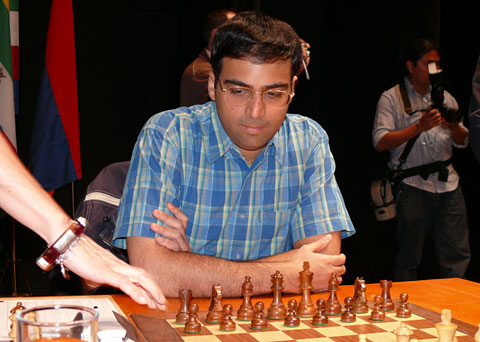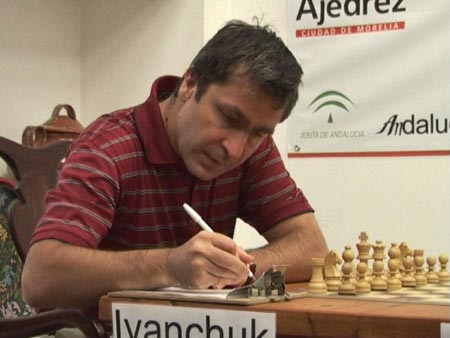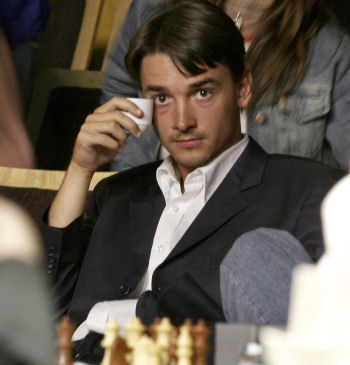| Latest | Greatest | Lobby | Journals | Search | Options | Help | Login |
|
|
|
This topic is archived. |
| Home » Discuss » Topic Forums » Sports |
|
| Jack Rabbit
|
Fri Mar-21-08 09:02 PM Original message |
| The Jach Rabbit Chess Report (March 21): Yifan takes Istanbul; Aronian leads in Nice |
|
Hou Yifan takes Istanbul
 Ms. Hou receives her trophy in Istanbul Hou Yifan of China, 14, won her first major international tournament this week by taking first prize in the Isbank Ataturk Women Masters� Tournament which finished yesterday (Thursday, March 20) in Istanbul. Ms. Hou, the youngest lady in the event, scored 7 points out of nine rounds to finish a full point over the senior participant, Sweden�s Pia Cramling. Chinese master Zhao Xue came from behind to finish third ahead of Ekaterina Atalik of Turkey, who played wonderful chess in the first half of the tournament only to collapse in the last three rounds. Aronian leads Amber Rapid/Blind  Armenian grandmaster Levon Aronian leads the 17th annual Melody Amber Rapid/Blindfold Tournament by a half point ahead of world champion Vishy Anand of India after six round in Nice. Aronian has scored 4� points in the rapid competition and 3 points in blindfold play for a combined total of 7� points. Anand, considered to be the world�s premiere rapid player, have 4 points in rapid games and 3 in blindfold. Aronian�s 4� rapid points top the table in that division, while Russian GM Alexander Morozevich and seventeen-year-old Magnus Carlsen of Norway share the lead in the blindfold competition with 4 points each. Neither Morozevich nor Magnus have done well in the rapid play, however. The tournament is scheduled for eleven rounds, with each round consisting of a blindfold game in the late afternoon and a rapid game in the evening. The city on Nice on the Mediterranean coast of France is hosting the event for the first time. All previous editions of the Amber Rapid/Blind have been held in Monte Carlo. |
| Printer Friendly | Permalink | | Top |
| Jack Rabbit
|
Fri Mar-21-08 09:03 PM Response to Original message |
| 1. Games from Istanbul |
|
Diagrams on the Jack Rabbit Chess Report are made with Chess M�rida, a true type font that can be downlaoded free here. !""""""""# $tMvWlVmT% $OoOoOoOo% $ + + + +% $+ + + + % $ + + + +% $+ + + + % $pPpPpPpP% $RnBqKbNr% /(((((((() WHITE White to move (This position is a theoretical draw) |
| Printer Friendly | Permalink | | Top |
| Jack Rabbit
|
Fri Mar-21-08 09:05 PM Response to Reply #1 |
| 3. Hou - Krush, Women Masters' Tournament. Round 7 |
 Hou Yifan Hou Yifan - Irina Krush Isbank Ataturk Women Masters' Tournament, Round 7 Istanbul, 17 March 2008 Open Sicilian Game: Sveshnikov Defense (Chelyabinsk Variation) 1.e4 c5 2.Nf3 Nc6 3.d4 cxd4 4.Nxd4 Nf6 5.Nc3 e5 6.Ndb5 d6 7.Bg5
7...a6 8.Na3 b5
9.Bxf6
9...gxf6 10.Nd5 f5
11.Bd3 Be6 12.c4
12...fxe4
13.Bxe4 Rc8!?
14.0-0
14...Bg7?
!""""""""# $ +tWl+ T% $+ + +oVo% $o+mOv+ +% $+o+nO + % $ +p+b+ +% $N + + + % $pP + PpP% $R +q+tK % /(((((((() WHITE: Hou Yifan Position after 14...Bf8g7 15.f4!
15...Nd4
!""""""""# $ +tWl+ T% $+ + +oVo% $o+ Ov+ +% $+o+nO + % $ +pMbP +% $N + + + % $pP + +pP% $R +q+tK % /(((((((() WHITE: Hou Yifan Position after 15...Nc6d4 16.Qh5!
16...b4
17.Nxb4 Qb6
18.Nd5 Qxb2 19.f5 Bxd5
20.Bxd5 0-0
!""""""""# $ +t+ Tk+% $+ + +oVo% $o+ O + +% $+ +bOp+q% $ +pN + +% $N + + + % $pW + +pP% $R + + + % /(((((((() WHITE: Hou Yifan Position after 20...0-0 21.f6!
21...Bxf6 22.Be4 Rfd8 23.Qxh7+ Kf8 24.Qh6+ 1-0
|
| Printer Friendly | Permalink | | Top |
| Jack Rabbit
|
Fri Mar-21-08 09:08 PM Response to Reply #1 |
| 4. Cramling - Atalik, Women Masters' Tournament, Round 7 |
 Pia Cramling Pia Cramling - Ekaterina Atalik Isbank Ataturk Women Masters' Tournament, Round 7 Istanbul, 17 March 2008 Ortodox Queen's Gambit: Ragozin Defense 1.d4 Nf6 2.Nf3 e6 3.c4 d5 4.Nc3 Bb4 5.cxd5
5...exd5
6.Bg5 Nbd7
7.e3 c5 8.Bd3 Qa5 9.Qc2 c4 10.Bf5 0-0 11.0-0 Re8 12.Nd2 g6 13.Bxd7
13...Nxd7 14.Bh4
14...Nb6
15.e4 Bxc3 16.bxc3 dxe4!?
17.Nxe4 Nd5 18.Rae1
18...Bd7 19.f3 Qa3
20.Qd2 Re6?!
!""""""""# $t+ + +l+% $Oo+v+o+o% $ + +t+o+% $+ +m+ + % $ +oPn+ B% $W P +p+ % $p+ Q +pP% $+ + RrK % /(((((((() WHITE: Pia Cramling Position after 20...Re8e6 21.Nc5!
21...Rxe1 22.Rxe1 Bc6 23.Ne4 Re8 24.Nf6+
24...Nxf6 25.Bxf6 Rxe1+ 26.Qxe1
26...h6 27.Qe5!
27...Qc1+?
28.Kf2 Kh7 !""""""""# $ + + + +% $Oo+ +o+l% $ + + BoO% $+ + Q + % $ +oP + +% $+ P +p+ % $o+ + KpP% $+ W + + % /(((((((() WHITE: Pia Cramling Position after 28...Kg8h7 29.h4!
29...Qc2+ 30.Kg3 Qf5
31.Qxf5 gxf5 32.h5 b5
!""""""""# $ + + + +% $O + +o+l% $ +v+ B O% $+o+ +o+p% $ +oP + +% $+ P +pK % $p+ + +p+% $+ + + + % /(((((((() WHITE: Pia Cramling Position after 32...b7b5 33.a3!
33...a5 34.Kf4 Kg8 35.Kxf5 b4 36.cxb4 axb4 37.axb4 c3 38.d5 c2 39.Bb2
39...Bxd5 40.b5 Kf8 41.Ke5 Be4
42.Kxe4
|
| Printer Friendly | Permalink | | Top |
| Jack Rabbit
|
Fri Mar-21-08 09:09 PM Response to Reply #1 |
| 5. Ushenina - Atalik, Women Masters' Tournament, Round 5 |
 Ekaterina Atalik Anna Ushenina - Ekaterina Atalik Isbank Ataturk Women Masters' Tournament, Round 5 Istanbul, 15 March 2008 Spanish Grand Royal Game: Worrall Opening 1.e4 e5 2.Nf3 Nc6 3.Bb5 a6 4.Ba4 Nf6 5.Qe2
5...b5 6.Bb3 Bc5
7.0-0
7...0-0 8.d3 d6 9.c3 h6 10.Rd1
10...Re8 11.h3
11...Bb6
12.Nbd2
12...Be6 13.Bc2
13...Nh5 14.Nf1 Qf6 15.N3h2
15...Ne7
16.Qf3 Nf4 17.Bxf4 exf4 18.a4
18...Ng6 19.d4?
!""""""""# $t+ +t+l+% $+ O +oO % $oV OvWmO% $+o+ + + % $p+ PpO +% $+ P +q+p% $ Pb+ PpN% $R +r+nK % /(((((((() WHITE: Anna Ushenina Position after 19.d3d4 19...Qg5 20.Qd3
20...Nh4 21.g4
21...fxg3 22.Qxg3 Bxh3 23.Ne3
23...Be6
24.Nhg4?!
!""""""""# $t+ +t+l+% $+ O +oO % $oV Ov+ O% $+o+ + W % $p+ Pp+nM% $+ P N Q % $ Pb+ P +% $R +r+ K % /(((((((() WHITE: Anna Ushenina Position after 24.Nh2g4 24...Ng6!
25.axb5 axb5 26.Rxa8
26...Rxa8 27.Nf5
27...Re8 28.Bd3
28...Bd7
29.Kf1 d5 30.f3
30...dxe4 31.fxe4 Bxf5 32.exf5 Nh4
33.Kf2
33...Nxf5
34.Nxh6+ Qxh6 35.Bxf5 Qf6 36.Qf3 b4 37.Rh1
37...g6 38.Bd3 Qxf3+
39.Kxf3 bxc3 40.bxc3
40...Kg7 41.Bb5
41...Ra8 42.Ke4
42...f5+ 43.Kd5 Rd8+ 44.Ke5 c5!
45.dxc5
45...Bxc5 46.Bc6 Bf2
47.Rh3 Bb6 48.Bd5
48...Bc7+ 49.Kd4
49...Bb6+
50.Ke5 Re8+ 51.Kd6
51...Kf6 52.c4 Be3 53.Rh7 f4
54.Rd7 Rc8 55.Rf7+ Kg5 56.Kd7
56...Rb8 57.Kc7
57...Rb6 58.Re7 Rf6
59.Bf3
59...Kh4 60.Re5 g5 61.c5 g4 62.Bd1
!""""""""# $ + + + +% $+ K + + % $ + + T +% $+ P R + % $ + + OoL% $+ + V + % $ + + + +% $+ +b+ + % /(((((((() WHITE: Anna Ushenina Position after 62.Bf3d1 62...Bxc5!!
63.Rxc5 f3 64.Rc4
64...Kg3 65.Kd7 Rf4 66.Rc1
66...f2 67.Be2 Re4 68.Bb5 Re1 69.Rc3+
69...Kh4 70.Kd6
!""""""""# $ + + + +% $+ + + + % $ + K + +% $+b+ + + % $ + + +oL% $+ R + + % $ + + O +% $+ + T + % /(((((((() WHITE: Anna Ushenina Position after 70.Kd7d6 70...f1Q!
71.Bxf1 Rxf1 72.Ke5 g3 73.Rc2 Kh3 74.Ke4 0-1
|
| Printer Friendly | Permalink | | Top |
| Mabus
|
Sat Mar-22-08 08:40 AM Response to Reply #1 |
| 9. It looks like the board is in the starting position |
|
The other diagrams in the thread are good but this one looks like the starting position.
|
| Printer Friendly | Permalink | | Top |
| Jack Rabbit
|
Sat Mar-22-08 10:39 AM Response to Reply #9 |
| 10. Yes, it is in the starting position |
|
Which, IMHO, is a theoretical draw.
I guess you downloaded the right font. |
| Printer Friendly | Permalink | | Top |
| Mabus
|
Sat Mar-22-08 10:47 AM Response to Reply #10 |
| 11. Had to, Leipzig didn't work |
|
fwiw, my husband taught chess for a number of years. I/We've used a number of chess fonts over the years to create chess tests for his students. I've got a lot of chess fonts on my computer.
I print out the games you've posted in the past and have shared them with my husband (who at this moment is playing on ICC). Thanks for all the work you do. |
| Printer Friendly | Permalink | | Top |
| Jack Rabbit
|
Fri Mar-21-08 09:04 PM Response to Original message |
| 2. Games from Nice |
|
Diagrams on the Jack Rabbit Chess Report are made with Chess M�rida, a true type font that can be downlaoded free here. !""""""""# $tMvWlVmT% $OoOoOoOo% $ + + + +% $+ + + + % $ + + + +% $+ + + + % $pPpPpPpP% $RnBqKbNr% /(((((((() WHITE White to move (This position is a theoretical draw) |
| Printer Friendly | Permalink | | Top |
| Jack Rabbit
|
Fri Mar-21-08 09:12 PM Response to Reply #2 |
| 6. Kramnik - Anand, Amber Rapid, Round 1 |
|
This is definately the game of the week. Some say it is the best game of chess played so far this year.
 Vishy Anand Vladimir Kramnik - Vishy Anand Melody Amber Tournament, Rapid Competion, Round 1 Nice, 15 March 2008 East India Game: Queen's Indian Defense (Bronstein Variation) 1.d4 Nf6 2.c4 e6 3.Nf3 b6 4.g3 Ba6
5.b3 Bb4+ 6.Bd2 Be7
7.Bg2 c6
8.Bc3
8...d5 9.Ne5
9...Nfd7 10.Nxd7 Nxd7 11.Nd2 0-0 12.0-0 f5
13.Rc1 Nf6
14.Bb2 Bd6!?
15.Nf3
15...Qe7 16.Ne5 Rac8 17.Nd3 Rfd8
18.Re1 Qe8 19.e3 g5 20.Rc2 g4 21.Qc1 Qe7
22.Rd1 Ne4 23.c5 bxc5 24.dxc5 Bb8
25.Ne5 Ng5
26.Qa1
26...Nf7 27.Nxf7 Kxf7
28.a4!?
28...h5?
29.b4 h4 !""""""""# $ VtT + +% $O + Wl+ % $v+o+o+ +% $+ Po+o+ % $pP + +oO% $+ + P P % $ Br+ PbP% $Q +r+ K % /(((((((() WHITE: Vladimir Kramnik Position after 29...h5h4 30.b5!
30...Bb7
31.Rdc1
31...Kg6
32.Be5!
32...Bxe5 33.Qxe5 Qf6 34.Qd4?!
!""""""""# $ +tT + +% $Ov+ + + % $ +o+oWl+% $+pPo+o+ % $p+ Q +oO% $+ + P P % $ +r+ PbP% $+ R + K % /(((((((() WHITE: Vladimir Kramnik Position after 34.Qe5d4 34...e5!
35.Qb4 hxg3 36.hxg3
36...Rd7 37.Qa5 Rh8! 38.Qxa7 f4
39.exf4 exf4 40.gxf4 Rdh7 41.Qb6?
41...Qxf4 42.bxc6
!""""""""# $ + + + T% $+v+ + +t% $ Qp+ +l+% $+ Po+ + % $p+ + Wo+% $+ + + + % $ +r+ Pb+% $+ R + K % /(((((((() WHITE: Vladimir Kramnik Position after 42.bc6:p 42...Qf3!!
43.cxb7+ Kf5
|
| Printer Friendly | Permalink | | Top |
| Jack Rabbit
|
Fri Mar-21-08 09:14 PM Response to Reply #2 |
| 7. Carlsen - Ivanchuk, Amber Blind, Round 1 |
 Vassily Ivanchuk Magnus Carlsen - Vassily Ivanchuk Melody Amber Tournament, Blindfold Competition, Round 1 Nice, 15 March 2008 Spanish Grand Royal Game: Gothic Defense (Open Defense) 1.e4 e5 2.Nf3 Nc6 3.Bb5 a6 4.Ba4 Nf6 5.0-0 Nxe4
6.d4 b5 7.Bb3 d5 8.dxe5 Be6
9.Be3
9...Qd7!?
10.c3?!
10...Nc5
11.Bc2 Bg4
12.Nbd2 Ne6?!
13.h3 Bh5 14.a4
14...Rb8 15.axb5 axb5 16.Bf5!
16...Be7 17.Nb3
17...0-0
18.Nbd4 Ncxd4 19.cxd4 Bg6
20.Bg4
20...Ra8 21.Qd2 h6
22.Nh2
22...c6 23.Rfc1
23...Rfc8
24.Rxa8 Rxa8 25.f4
25...h5 26.Be2 !""""""""# $t+ + +l+% $+ +wVoO % $ +o+m+v+% $+o+oP +o% $ + P P +% $+ + B +p% $ P Qb+pN% $+ R + K % /(((((((() WHITE: Magnus Carlsen Position after 26.Bg4e2 26...Ra2!
27.g4
27...Be4 28.f5 Nf8 29.Rf1
29...Ba3!
30.Qe1 Rxb2 31.gxh5 Bb4
32.Qf2 Qxf5 33.Qg3 Rb1
34.Ng4
34...Rxf1+ 35.Bxf1 Kh7 36.h6
36...Ng6 37.hxg7 Kxg7 38.Be2
38...Be7
39.Nh6 Qd7 40.Qf2?
!""""""""# $ + + + +% $+ +wVoL % $ +o+ +mN% $+o+oP + % $ + P + +% $+ + B +p% $ + +bQ +% $+ + + K % /(((((((() WHITE: Magnus Carlsen Position after 40.Qg3f2 40...Bh4
41.Qf1 b4
42.Bg4 Qe7 43.Nf5+
43...Bxf5 44.Qxf5
44...b3 45.Qh5 Qb4 46.Qh6+ Kg8 47.e6
47...Qe1+ 48.Kg2 Qg3+ 49.Kf1 b2
50.exf7+ Kxf7 51.Qh7+ Kf6 52.Qb7 Qxe3 53.Qxc6+ Kg5 0-1
|
| Printer Friendly | Permalink | | Top |
| Jack Rabbit
|
Fri Mar-21-08 09:15 PM Response to Reply #2 |
| 8. Morozevich - Topalov, Amber Blind, Round 2 |
 Alexander Morozevich Alexander Morozevich - Veselin Topalov Melody Amber Tournament, Blindfold Competition, Round 2 Nice, 16 March 2008 Orthodox Queen's Gambit: Harrwitz Opening (Exchange Variation) 1.d4 d5 2.c4 e6 3.Nc3 Be7 4.cxd5 exd5 5.Bf4 c6 6.e3 Bd6
7.Nge2
7...Ne7
8.Bxd6 Qxd6 9.Ng3 0-0 10.Bd3 Nd7 11.Qc2 Nf6 12.0-0-0!?
12...Bd7 13.Kb1 c5
14.dxc5 Qxc5 15.e4 d4?!
!""""""""# $t+ + Tl+% $Oo+vMoOo% $ + + M +% $+ W + + % $ + Op+ +% $+ Nb+ N % $pPq+ PpP% $+k+t+ +t% /(((((((() WHITE: Alexander Morozevich Position after 15...d5d4 16.Nce2!
16...Qb6 17.Nxd4 Ng4
18.h3 Rac8 19.Qe2
19...Ne5 20.Bc2 N7g6
21.Bb3 a5 22.Ngf5 a4
23.Bd5 a3 24.b3 Nf4?
25.Ne7+
25...Kh8 !""""""""# $ +t+ T L% $+o+vNoOo% $ W + + +% $+ +bM + % $ + NpM +% $Op+ + +p% $p+ +qPp+% $+k+r+ +r% /(((((((() WHITE: Alexander Morozevich Position after 25...Kg8h8 26.Qe3!
26...Nxg2
27.Nxc8 Rxc8 28.Qg3!
28...Qc5
29.Qxe5 Qc3 30.Nc6 Qf3 31.Nb4 Nf4 32.Rhg1 f6 33.Qe7 Bg4 34.Rc1 1-0
|
| Printer Friendly | Permalink | | Top |
| Jack Rabbit
|
Sun Mar-23-08 01:02 AM Response to Original message |
| 12. Happy birthday to the Grand Old Man of Chess |
| Printer Friendly | Permalink | | Top |
| Lithos
|
Fri Mar-28-08 11:05 PM Response to Reply #12 |
| 13. Cute |
|
Shows he has a good sense of humor.
L- |
| Printer Friendly | Permalink | | Top |
| DU
AdBot (1000+ posts) |
Fri Apr 19th 2024, 04:31 PM Response to Original message |
| Advertisements [?] |
| Top |
| Home » Discuss » Topic Forums » Sports |
|
Powered by DCForum+ Version 1.1 Copyright 1997-2002 DCScripts.com
Software has been extensively modified by the DU administrators
Important Notices: By participating on this discussion board, visitors agree to abide by the rules outlined on our Rules page. Messages posted on the Democratic Underground Discussion Forums are the opinions of the individuals who post them, and do not necessarily represent the opinions of Democratic Underground, LLC.
Home | Discussion Forums | Journals | Store | Donate
About DU | Contact Us | Privacy Policy
Got a message for Democratic Underground? Click here to send us a message.
© 2001 - 2011 Democratic Underground, LLC